Episode 150: Galileo’s Jovian Journey
Table of Contents
After checking in with it for years, Galileo has finally arrived at Jupiter. For the 150th episode of The Space Above Us, let’s find out what the Galileo orbiter and probe did while they were out there and why it was worth the wait.
Episode Audio #
Photos #
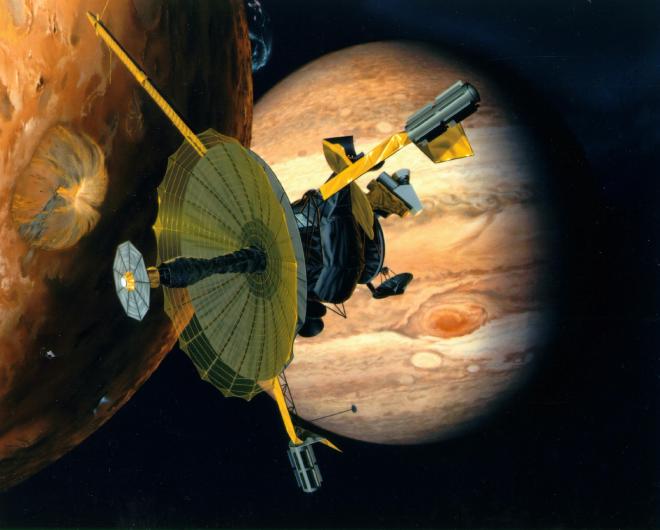
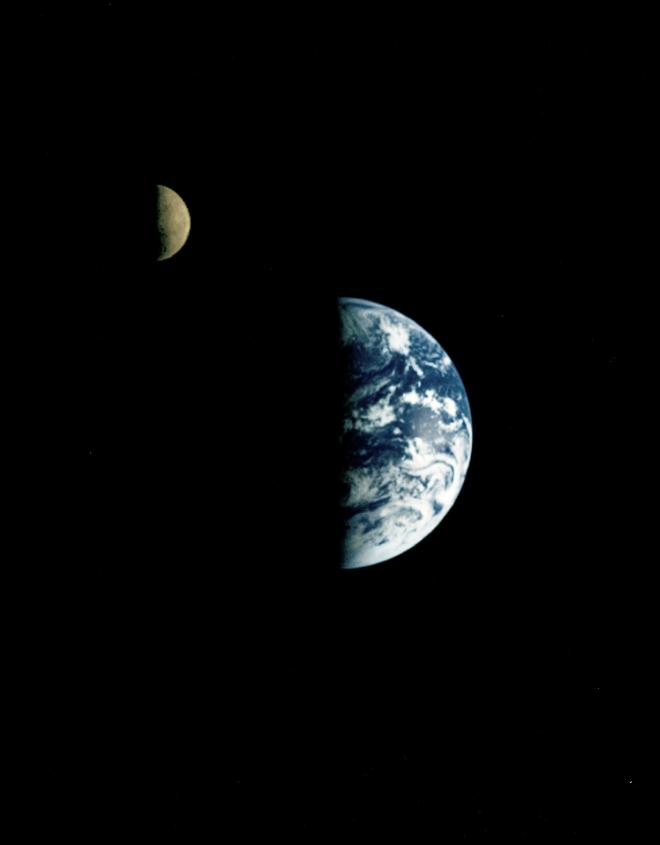
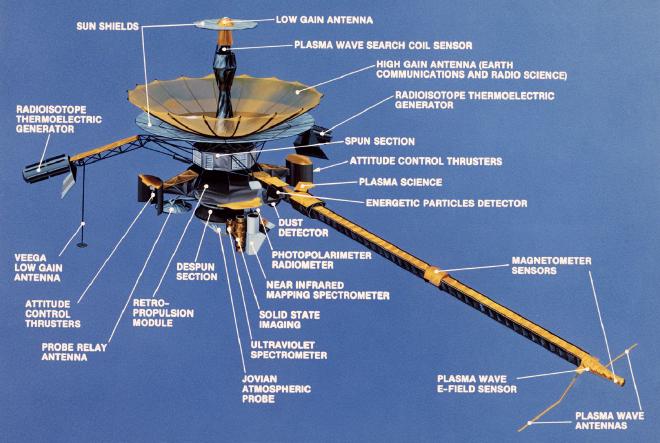
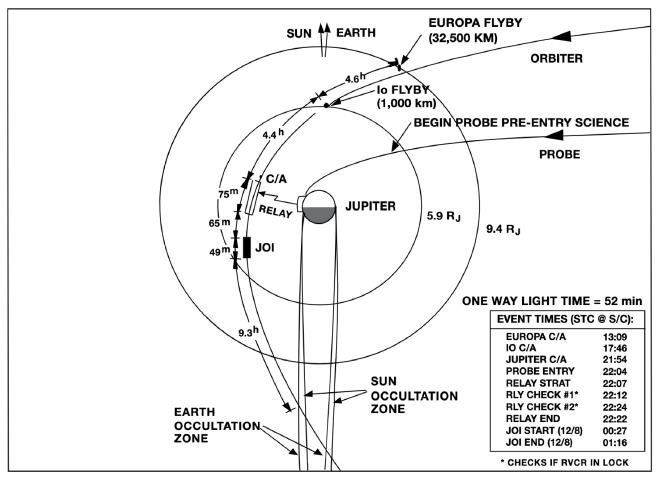
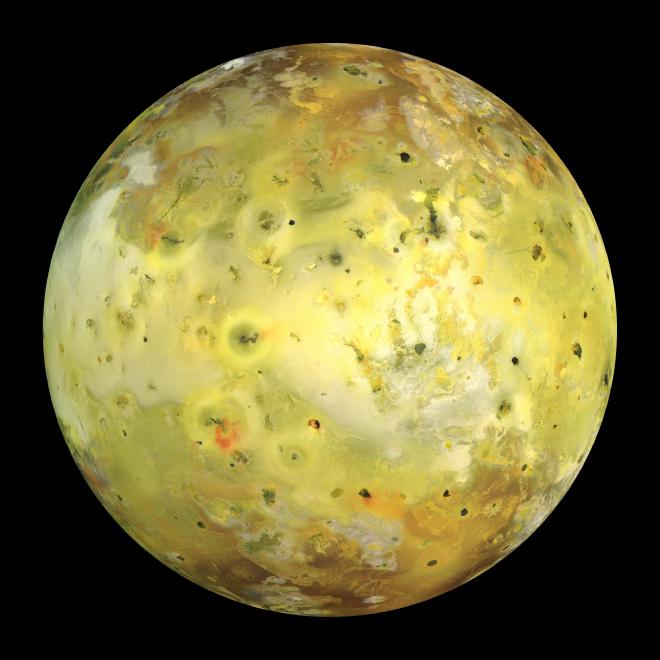
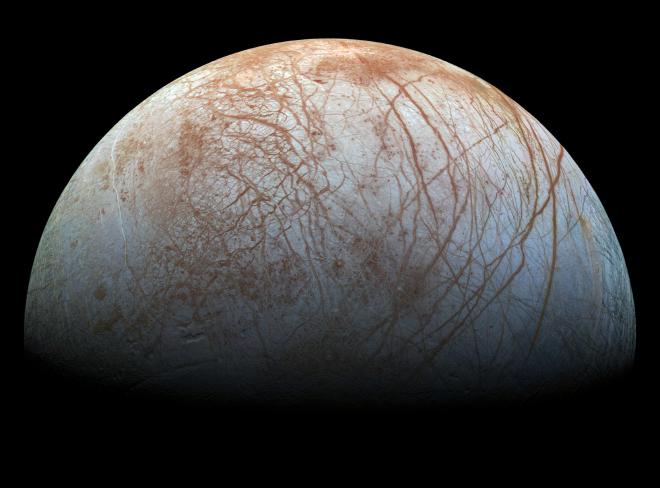
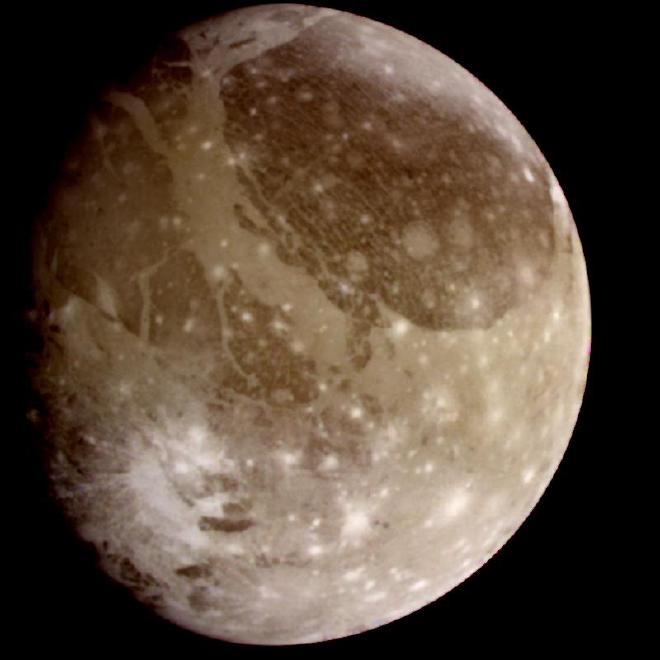
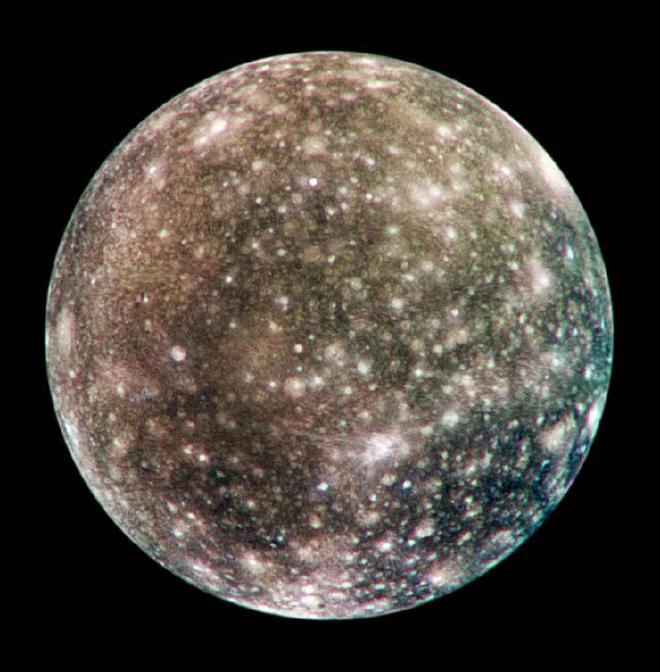
For more photos, head over to our friends at Wikiarchives.space: https://wikiarchives.space/index.php?/category/1438
Transcript #
NOTE: This transcript was made by me just copying and pasting the script that I read to make the podcast. I often tweak the phrasing on the fly and then forget to update the script, so this is not guaranteed to align perfectly with the episode audio, but it should be pretty close. Also, since these are really only intended to be read by myself, I might use some funky punctuation to help remind myself how I want a sentence to flow, so don’t look to these as a grammar reference. If you notice any egregious transcription errors or notes to myself that I neglected to remove, feel free to let me know and I’ll fix it.
Hello, and welcome to The Space Above Us. Episode 150: Galileo’s Jovian Journey
Last time, we picked up a Japanese satellite that needed a ride home, tried out some new technology that could be used on future missions, and continued our series of spacewalks aimed at preparing for the upcoming International Space Station. It was a pretty busy flight, packing all of that and more into a little under nine days. But we’ve grown pretty used to that kind of pace here on the show. STS-72 was the 109th mission we’ve covered, with only the Skylab missions lasting more than two weeks. We’ve grown accustomed to the all-out frantic pace of these missions, often working around the clock to squeeze every useful second out of a brief journey beyond the atmosphere. Human spaceflight comes with many benefits, but one major downside is that keeping people in space for a long time is tough, which means that a typical mission at this point in the story has only been around a week long. Well, human spaceflight isn’t the only game out there. And some missions pass through a week like it was the blink of an eye..
Why am I mentioning this? Because after six years of flying through space at incredible speeds, an old friend is finally arriving at its destination. The Galileo spacecraft was deployed from Space Shuttle Atlantis on October 18th, 1989 as the primary objective of STS-34, 43 shuttle flights ago. Since that time, it has been journeying around the solar system, gathering the required velocity to make one big push up to the outer planets, and then waiting, and waiting, and waiting. Ever since that deployment, in an attempt to give a feel for the different character of an uncrewed robotic mission, we’ve been checking in with Galileo at key milestones. And through a stroke of good luck, the tenacious spacecraft has arrived at its target right as The Space Above Us hit its 150th episode. Well, really it arrived in between the 148th and 149th episodes, but don’t tell anybody. I figured that this made for a perfect opportunity to put our shuttle coverage on hold for a week and find out what Galileo did when it finally began its actual mission.
But first, since this is a major milestone, I get to do my favorite game of trotting out a bunch of useless statistics. If this means nothing to you then apologies, but I always love when the podcasts I listen to give these sorts of stats, so here we go. If we were to add up the previous 149 episodes, not including the supplementals, the show comes out to 65.8 hours of audio, which is about 2.7 days. In total, the scripts add up to around 656,000 words. I think it’s pretty safe to say at this point that I’ve written more for this show than in all my years of school combined. Who knew I had it in me.
That’s more than enough patting myself on the back, but I have one more stat related to the podcast. If Galileo had been deployed from the shuttle on the same day that the first episode went live.. we would still have to wait a few more months until it reached Jupiter. So yeah, it’s been going for a long time. I’m going to assume that you paid attention to the earlier episodes, and we’re going to start our story in 1995, with Galileo nearly in the Jovian system.
If you were to find yourself drifting through space in the general vicinity of Jupiter in 1995, and if you were incredibly lucky, you would have seen something unusual. Cruising along from the inner solar system was a spindly looking spacecraft, serenely spinning at around three rotations per minute. The main body of the spacecraft made up most of its 2200 kilogram mass, and was basically a 5.3 meter tall cylinder with a whole bunch of stuff sticking out of it. Three main appendages stuck out at nearly equidistant angles, with one in particular extending further than the others, out to 11 meters. Directions are kind of tricky in space, but we could say that on the bottom was a stationary conical structure, not spinning like the rest and on the top was an oddly shaped asymmetrical mesh-like structure.
This was the Galileo Orbiter and Probe. Inside that 2200 kilogram body were computers, heaters, radiators, a tape recorder, signal processing electronics, a dozen scientific instruments, and 7500 meters of wires to connect it all together.
Two of the long appendages contained radioisotope thermal generators, clever devices that harvested the heat from radioactive plutonium in order to generate electricity. The third, and longest, appendage, housed delicate magnetometers and plasma detectors. The instruments were so sensitive that they had to be placed on the end of an 11 meter long boom so as not to pick up the faint electromagnetic disturbances from the spacecraft’s own computer, as well as getting to sample any plasma without it being disturbed by the spacecraft itself flying through it.
The conical structure on the bottom was the atmospheric probe that would soon meet a fiery and dramatic end. It was stationary compared to the rest of the spacecraft because the Galileo Orbiter was made up of two major parts, a spinning section and a de-spun section. A spinning spacecraft comes with a number of advantages. It can sweep instruments through space, which is great for studying fields and particles, and it provides some extra stability during propulsive maneuvers. But it’s terrible if you’re trying to take a clear picture. For this reason, the de-spun section housed instruments like an onboard camera, which needed to be stably pointed in one direction for long periods of time. Some tricky engineering had to be done in order to reliably convey power and data from the spinning section to the de-spun section, but the system was working great.
Not everything was working great though. I mentioned an asymmetrical mesh structure on the top of the spacecraft. Well, that was supposed to be a nice big (and symmetrical) high gain antenna. Galileo would be collecting a precious trove of science data, and in order to send it back through the vast distances to Earth, it needed a powerful antenna. Unfortunately, as covered in previous episodes, the antenna was stuck. Detailed analysis using the signals from sun sensors, changes in the rate of spin during antenna deployment, careful examination of similar mechanisms on the ground, data from the onboard electrical motors, and other clues lead NASA to conclude that the antenna has only partially deployed. Several of the longitudinal ribs that gave the antenna its structure had become stuck to the central pillar, only allowing a small part on the opposite side to deploy. The likely culprit? Multiple long truck journeys between JPL in California and the Kennedy Space Center in Florida had worn down the Teflon coating on the restraint pins holding the ribs in place. With that coating gone, once Galileo was in space, and subject to more vibration during deployment and powered flight, the pin cold-welded to its receptacle. The upshot was that that the high gain antenna was useless. Instead of a 134,000 bits per second stream of data coming from the high gain antenna, the mission would have to make do with the ten to forty bits per second of data coming from the low gain antenna. At best, that’s 0.03% of the original bitrate. Quite a downgrade.
This was obviously a setback, but that’s ok, NASA engineers are pretty clever and determined people. During the long trek out to Jupiter, they came up with a new way to execute the mission. By using some new compression algorithms and a backup tape recorder on the spacecraft, almost all of the original science goals could still be completed. Galileo would record data at a high rate onto the tape recorder and then slowly play it back over the low gain antenna. But this also meant that suddenly the hopes of the entire mission rested on a single strip of mylar tape, not too different from an audio cassette. So of course, right as Galileo was nearing Jupiter.. there was an issue with the tape recorder.
The problem was that Galileo was instructed to rewind its tape, which it did.. but then it never stopped. It just kept spinning. It had failed to detect the end of the tape. Folks on the ground knew this because, in a frankly bizarre coincidence, similar equipment on the ground failed in the same way at almost the same time. And not only that, when the tape recorder on the ground reached the end of its tape and just kept going, it tore the tape right off the reel. It this was what had happened to Galileo, there would be no way to repair it. This was.. very bad! In order to test if this tragedy had, in fact, occurred, mission controllers asked Galileo to play back a small part of the tape. When Galileo sent down valid data, they knew that the tape was still intact and that the immediate crisis was averted. However, there was a catch. Since the mechanism had been dutifully whirring away, trying to move the tape for something like 15 hours, there was a good chance that it had weakened that part of the tape. It was as if someone had taken very very fine sandpaper to it. That weakened portion of tape could still snap and make the recorder useless. To guard against this, that end of the tape was wound around its reel 25 times, which would hopefully keep it firmly in place. The cost of this extra reinforcement was that the section of tape in those 25 wrappings could never again be accessed during the mission. This reduced the overall storage space available and doomed some images and data to live on the end of the tape forever, never being transmitted.
And unfortunately, that wasn’t the only sacrifice made necessary due to the suspect tape recorder. We know now that the tape recorder continued to work for the entire mission, but at the time there was no way to be sure. With that in mind, Project Management wanted to focus on guaranteeing the success of the top priority objectives. In a few weeks, the atmospheric probe would disappear beneath the clouds of Jupiter, transmitting critical scientific data to the orbiter as it passed overhead. They only got one shot at receiving that data, but they would hopefully be orbiting Jupiter for a few years. So the difficult decision was made to cut the planned photographic observations of the Jovian moons Europa and Io, hopefully making up for it later. Taking photos put more strain on the tape recorder due to the intermittent bursts of high data rate required, and it might prove to be too much for the weakened tape. This would still be the case when they used it later, but at least they would have gotten the atmospheric probe data. To the scientists who had waited decades for their first close up look at the two moons, it was difficult news. Especially because this was the only close up pass of Io planned for the entire primary mission. Its orbit was so close to Jupiter that flying past Io meant flying through massive amounts of radiation, which isn’t the best thing for the health and safety of the vehicle. Don’t worry though. It’ll take a little longer than expected, but the Io story has a happy ending after all.
So it was that on November 16th, 1995, after decades of planning, years of delays, multiple switches back and forth between the IUS and Shuttle-Centaur, several trips between California and Florida, six years in space, and some careful cassette tape winding, Galileo finally limped into the Jovian system. This was made official when Galileo’s magnetometer detected that it had passed into the magnetosphere of Jupiter, if only temporarily. Jupiter’s magnetosphere is so big that if it were visible to the human eye it would appear to be three times bigger than the moon in the sky. Even across all that distance. The solar wind caused the boundary to flap around, like a plastic bag in the wind, passing in front of and behind Galileo several times before the spacecraft eventually moved beyond those fluctuations. Arrival Day, December 7th, 1995, was rapidly approaching.
The plan for orbital insertion day is one of these things that’s easy to rattle off in a sentence, but not so easy to actually execute. Five months earlier, the atmospheric probe had separated from the rest of Galileo, carefully aimed such that it would skim along the upper atmosphere of the gas giant. Galileo then fired its thrusters to ensure that rather than crashing into Jupiter, it would zoom less than 900 kilometers past Io, using the moon’s momentum to slow down a bit, before continuing on to be in position to catch the signal coming from the atmospheric probe.
As the probe screams through the atmosphere of Jupiter and eventually turns into vapor, let’s follow along and learn a bit about it. The overall structure looked like an oblique cone about 1.2 meters across and with a dome on top of it, all of it weighing about 335 kilograms. You can kind of imagine a small Apollo command module, but flying point-first. Altitude on Jupiter is measured from the point in the atmosphere where the air pressure is the same as on the Earth at sea level. 450 kilometers above that, approaching at a shallow 8 degree angle, the probe first made contact with Jupiter’s atmosphere. When it first made contact, the probe was moving at an incredible 47-and-a-half-thousand meters per second. That’s 171,000 kilometers per hour, of 106,000 miles per hour. If you could fly that fast, you’d be able to fly from the Earth to the Moon in less than two-and-a-half hours. 35 seconds after entry interface, the probe had already descended 230 kilometers, with its exterior glowing at 14,000 degrees Celsius. For a comparison, the nose cone of the space shuttle orbiter, the hottest part during reentry, hits a peak temperature of around 1650 degrees Celsius, around 8 times cooler. 55 seconds after entry the probe experienced its maximum deceleration: a punishing 250 G’s. After three minutes it cooled down enough that its main parachute deployed, discarding the scorched heat shield, its job complete. The probe then settled in for a leisurely descent, hanging from its parachute.
Its main goals were to figure out the temperature, pressure, density, and chemical composition of the atmosphere as it descended, while also measuring the energy balance, any atmospheric particles it encountered, and the location and structure of clouds. All of this data would be used to confirm or refute the predictions of what planetary scientists expected to find. If they were right, then they probably had a pretty good theory of planetary formation. If they were wrong, then it was time to start working on a new theory that supported the new data. To gather this data, the probe carried six instruments: a neutral mass spectrometer (which analyzed what chemicals were in the air), a helium abundance detector, an instrument to measure the temperature, pressure, density, and molecular weight of the atmosphere, a nephelometer (which sounds made up but is an instrument that characterizes cloud particles), a lightning detector, and a radiometer (which measured energy moving up and down through the atmosphere). In addition to that, by studying the characteristics of the probe’s radio signal, the radio itself became an instrument.
After about an hour, the atmospheric pressure had increased to ten times that of Earth’s, and the signal to the probe was lost. It would continue down until the incredible pressures broke the probe and its components down into individual atoms. It was now a part of Jupiter.
Due to the great distances involved and the constant speed of light, even if the probe’s data was being relayed immediately it would’ve almost been dead by the time the signal got to Earth. But thanks to Galileo’s high gain antenna issue, instead of relaying the data in realtime, it recorded it to its tape recorder, only transmitting a single bit to indicate if was receiving data at all. That one little digital thumbs up was all the scientists got until Galileo could slowly replay the data.
So what did it find? Well.. basically the planetary scientists got it completely wrong. Jupiter’s atmosphere had far less water vapor than expected, it was almost twice as windy as expected, and the three distinct cloud layers that had been predicted were either much thinner than expected or absent entirely. They pretty much nailed the expected level of helium though, so that’s something. So all of the theories were basically completely wrong, right? Well.. maybe. And here’s the trouble with doing science with something like a one shot atmospheric probe. What if it just flew through a weird place? What if it threaded the needle between a bunch of clouds by chance? What if there was a ton of water vapor in a band just a little north or south? Unfortunately, until the resources exist to study more slices of Jupiter’s atmosphere, we’ll have to make do with what we’ve got. But that’s how science works. Get new data, test the old predictions, make a new theory, make new predictions, get new data, repeat. In any case, it’s safe to say that the probe’s mission was a complete success.
Meanwhile, high above the puff of atoms that was formerly known at the atmospheric probe, the Galileo orbiter was just getting started. About an hour after the signal from the probe disappeared, Galileo fired up its propulsion system for 49 minute long burn, bleeding over 600 meters per second off of its velocity, and becoming the first human-made object to orbit Jupiter. There would be plenty of time to analyze what had happened and to plan the next close approach to the gas giant, however. Because while Galileo was in orbit.. that orbit was so big that it would take seven months to return. During that time, scientists on the ground learned a lot. They received the data from the probe, which allowed them to draw the conclusions we just talked about. And while they didn’t get any images of Io and Europa, Galileo’s other instruments were running, so they could still start to piece together what was going on up there. The plasma and magnetometer sensors especially were interesting due to the interactions of the moons with the giant ball of plasma they were flying through. Our moon is so far away from the Earth that it spends most of its time not really interacting with our magnetosphere. But Jupiter’s moons were well within its gigantic magnetosphere, which also traps ionized gas, aka plasma. That plasma responds to changes in the electromagnetic environment, and also interacts with the moons in ways scientists had never had a chance to examine up close.
Scientists also learned that they were right to be wary of getting so close to Jupiter. On this initial approach, they had passed within four radii of the planet. In that pass it received almost half the radiation allotted for the entire primary mission. So while it was puttering along near the high point of its orbit, Galileo did another burn to raise its periapsis to 10 Jupiter radii, which was a much more benign environment. It would later lower the high point of its orbit such that its orbit changed from seven months to a more reasonable one-to-three months.
Over the next two years, the spacecraft would plunge down towards Jupiter 11 times, performing close approaches and gathering data, then slowly sending that data back to Earth. In May of 1996 it flew by Ganymede, then again in September. Two months later, it flew by Callisto, and then a month later, just over a year after Arrival Day, it flew by Europa. These close approaches served two purposes. First, Galileo could use its suite of scientific instruments to study these moons from closer distances and longer time spans than had been possible with earlier planetary flyby missions. But second, the spacecraft could sort of surf on the gravity of these moons to save a little propellant. By carefully crafting the geometry of these Jovian moon flybys, engineers on the ground could tweak Galileo’s trajectory for free. Well, almost for free. Rather than burning its engine for hours and hours to arrange its next close encounter, a carefully planned nudge would ensure that one close encounter lead to another. By doing this, over the entire two year primary mission, Galileo only used its thrusters to impart 100 meters per second of changes to its orbit.. but since it used that 100 meters per second to set up useful flybys, it benefited from six thousand meters per second of delta-v.
For month after month, Galileo swooped around the Jovian system, putting its suite of instruments to good use. Among these were the magnetometer and plasma wave instruments we already briefly discussed. Also on board were systems for detecting dust as well as energetic charged particles. There were also a number of remote sensing instruments. NIMS, the Near Infrared Mapping Spectrometer broke down infrared light into its constituent parts, allowing scientists to determine the chemical composition of Jupiter and its moons. The Photopolarimeter Radiometer measured the total energy being radiated from the various orbiting bodies, using a polarimeter to study things like the particles of Jupiter’s clouds. The ultraviolet spectrometer, just like NIMS, broke down light into separate frequencies, but this time in the ultraviolet range. This allowed it to study the upper atmosphere of Jupiter and look for atmospheres around its moons. And lastly, there was the Solid State Imaging camera.
Out of all of these, I would suspect that the solid state imaging camera was the real crowd pleaser. People can appreciate the value of more abstract scientific data, but everyone, even space nerds like us, really has their attention drawn by big pretty pictures. And that’s what this camera delivered. Its primary science value was to study the geology of the moons of Jupiter. But what made front page news wasn’t necessarily detailed breakdowns of the geology of Callisto, but rather full color photographs returned from half a billion miles away. The bizarre and ever-changing volcanic face of Io, the intriguing dark and light splotches across Ganymede and Callisto, and the deep striations covering Europa, perhaps a thick shell over a hidden ocean of liquid water.
If there’s one thing I’ve learned from reading about robotic spacecraft, is that nothing builds public support quite like sending home pretty pictures. Sometimes that can come at the expense of another instrument that maybe would have returned more science data, but I’m of the mind that everything we send everywhere should be equipped with a camera.
So month after month, orbit after orbit, Galileo used its solid state imaging camera to take pretty (and useful!) pictures, while also putting every other scientific instrument to good use, unlocking the mysteries of Jupiter.
Two years after arriving, Galileo’s primary mission was complete. But despite its technical problems, the spacecraft was still generally in good shape. So funding was approved for another two years of operations, and the Galileo Europa Mission, or GEM began. In a way, you can think of this as an entirely new mission that just happened to be benefiting from having their spacecraft already at the target destination. 80% of the staff moved on to other projects, leaving only about 40 people working full time on Galileo. But that also meant that two years of operations would only cost $30 million. For that price, the project got 14 more orbits. The first 8 were dedicated to flybys of Europa, as you may have guessed from the name “Galileo Europa Mission”. On December 16th, 1997, the spacecraft flew within only 201 kilometers of the icy moon, even getting a taste of its extremely thin atmosphere.
After that came four orbits that passed close to Callisto. And then finally, three years later than planned, two close approaches to Io, zipping by at a distance of only 300 kilometers.
Lastly, with GEM complete and the spacecraft still working well, it entered its third and final mission, the Galileo Millennium Mission, or GMM. The goal here was partially to try to answer some questions that had been raised earlier in the mission. Topics included the interplay between the solar wind and Jupiter’s magnetosphere, giant storms in its atmosphere, streams of dust found to be moving through the Jovian system, and further investigations of Io. It also performed some observations alongside another outer planet traveler, Cassini, on its way out to Saturn. Cassini’s main goal with visiting Jupiter was to benefit from a gravity assist maneuver and reduce the time required to fly to Saturn, but the close approach presented a great opportunity to gather some data on Jupiter. This was both great for scientists as well as for the engineers operating the instruments since it could serve as a sort of dress rehearsal for Saturn.
All good things must come to an end eventually, though. After nearly eight years of orbiting Jupiter, Galileo’s systems were having some trouble. Already, it had far outlasted its primary mission goals, and repeated trips through the intense radiation belts surrounding Jupiter had caused cumulative damage to its instruments and systems. Rather than continue until that degradation caused an unplanned loss of contact with the spacecraft, NASA decided to end things on their own terms. One concern was that an abandoned Galileo might one day crash into the surface of Europa. This was a concern because as we now know, thanks to sending spacecraft out to take a look, Europa might have a liquid water ocean deep under its frozen surface, and such an ocean might contain life. If Galileo crashed there and some hardy bacteria or organic compounds managed to survive the impact, then years from now if we discovered life there, it would be the life we accidentally brought! So instead, Galileo fired up its thrusters, and at the end of its 35th trip around Jupiter it would get its closest encounter yet: impacting the planet and disappearing beneath the clouds.
What was Galileo’s legacy? Well, that’s a really big question, but we can get into some of the scientific data it returned. No gas giant had been studied up close before, and Galileo had just spent 8 years taking photos, measuring magnetic fields, finding dust streams, and breaking down light from moons to see what they’re made of.
It characterized the atmosphere of Jupiter, believed to be representative of the material that formed the early solar system. It identified Io as the most geologically active object in the solar system, with over a hundred volcanoes constantly changing its surface.
It found evidence for liquid water under the surface of Europa, with long cracks perhaps being linear geysers, spraying water onto the surface. This could account for the ice moon’s lack of craters. If the surface is constantly getting sprayed over with new water and ice, any craters would quickly be hidden.
By precisely monitoring the radio signal coming from Galileo, scientists were able to measure the subtle changes in the tug of gravity as it passed by different moons, giving clues into their internal structures.
And it also raised its own questions when observations, like the expected cloud layers in the atmosphere, so thoroughly refuted expectations. Those questions are one reason why at the time of this writing, another spacecraft is orbiting Jupiter: Juno.
Really, fully digging into the orbit by orbit discoveries and a complete breakdown of the scientific findings could fill an entire book. And, in fact, it has. With today’s story being so different than the now-typical shuttle coverage, I had to find some new sources. I used a few, but the primary source for today’s story was an excellent book by Michael Meltzer called Mission to Jupiter: A History of the Galileo Project. And actually, since this book was published by the NASA history office, it’s freely available as a PDF on NASA’s website. You can learn more about the long and challenging road to building the spacecraft in the first place, wanna-be aerospace engineers in Congress requesting changes, the impact of the Challenger accident, the nitty gritty details about the high gain antenna failure, and page after page after page of details about Galileo’s scientific findings. It’s definitely worth a look.
Next time.. what you got is what they need and all they do is dirty deeds. Watch out! It’s the return of the space ball!
Ad Astra, catch you on the next pass.
